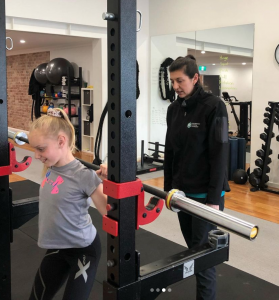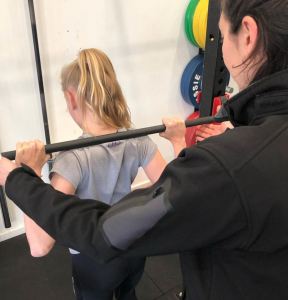When you think of kids exercising, what comes to mind? Running around, kicking a ball or playing on the playground are often the first things we associate with children and exercise, not strength training. But what if we told you that as part of the 60min daily physical activity that the World Health Organisation recommends for kids aged 5-17, it’s also recommended that children and adolescents incorporate activities that strengthen muscle and bone at least three times a week (1). That includes running, jumping, and yes, even lifting weights. Historically we were worried about children loading their bodies as they grow however we now have a much deeper understanding of the importance of regular resistance training in kids.
So, what are the benefits ? Are there any potential risks? What does this kind of training involve?

Firstly, we have a few myths to bust:
Myth: Lifting weights and doing strength exercises will stunt a child’s growth.
Fact: There is actually no scientific evidence that children who participate in a well-designed weight training program will have stunted growth or cause harm to their developing skeleton. In fact, the consensus is that exercise, particularly weight-bearing exercise actually positively influences children’s bone growth and the development of their muscular and skeletal system as a whole (2).
Myth: Strength training is inherently dangerous.
Fact: Resistance training is a safe, effective and worthwhile activity for children in fact studies have shown resistance training has a much lower incidence of injury then in team sports. Learning how to exercise is the key and this can be done with a qualified exercise professional (for example, an Exercise Physiologist or Exercise Scientist), designed well and undertaken with an emphasis on movement practice.
Myth: Kids naturally become inactive, or ‘outgrow’ physical activity, unless they take part in sport.
Fact: Physical activity is a learned behaviour, meaning that it is something that is influenced not only by the child’s inherent interests, but also by their family, friends and their environment. It has been proven that children that are given regular opportunities take part in physical activity not necessarily just as part of sport but as part of everyday life are more likely to be active as they get older (4).
Statistics are showing that children are becoming more sedentary and more overweight
In 2017–18, 1 in 4 (25%) Australian children and adolescents aged 2–17 were overweight or obese, and 1 in 12 (8.2%) were obese. Obesity in children is caused by overeating or eating unhealthy options regularly, not enough physical activity and more often being sedentary. Managing these behaviours early by increasing physical activity, will prevent health concerns and long term poor health behaviour as adults.
So what are the benefits of strength exercises or resistance training?
 Proper programs have an assortment of associated benefits. This includes increased strength, lower risk of sports-related injury, increased bone strength, lower risk of fracture as well as improving heart and lung health. It also provides an opportunity to improve emotional, social and cognitive well-being (5).
Proper programs have an assortment of associated benefits. This includes increased strength, lower risk of sports-related injury, increased bone strength, lower risk of fracture as well as improving heart and lung health. It also provides an opportunity to improve emotional, social and cognitive well-being (5).

Alongside these benefits, tailored programs also provide children with an opportunity to learn movement skills that are fundamental and transferable to everyday life, such as jumping and landing safely, running and lifting and throwing objects. Starting from as young as 8-10 years old is the best time to learn these skills, as your brain is still developing and adapting (4). We aren’t born automatically knowing these skills, so why not get a head start and practice them early – they’re more likely to stick that way!
NOTE: See the photos of Sarah at 11 years old learning how to do a barbell back squat. Sarah is able to squat with 15kg on her back comfortably for 10 repetitions. Sarah plays netball and teaching her a simple squatting movement will assist in improving her leg strength and power to be able to improve her sport performance as well as set adequate training behaviour as an athlete wanting to strive in her given sport.


What are the risks?
Studies have shown there is no increased risk of bone or soft-tissue injury when using both machine and free weights in a controlled environment, supervised by a professional (6), (7). Additionally, though a minor risk of injury does exist, as in with any physical activity, it is minimal, and when conducted safely the risk is lower when compared to sports that children commonly take part in, such as football, basketball and soccer (8).
So that’s all well and good, but what does it involve and how do I get started?
When we usually think of strength training, big heavy weights or machines, with athletes or “gym-bros” looking in the mirror often come to mind. However, strength training doesn’t have to be so intimidating – it doesn’t initially even have to involve any weights whatsoever!
While there are minimal risks involved, it’s still important to assess and take into account your child’s needs and goals. When introducing anyone, especially children to resistance training, there are three main things that are important to set them up for success:
- Education regarding safe lifting and exercise (that is, the safe way to complete the exercise).
- Proper supervision and planning by an accredited exercise professional (either an Accredited Exercise Scientist (AES) or Accredited Exercise Physiologist (AEP)).
- Perhaps most importantly – gradual progression of exercises in a way that is fun, relatable and individualised (5). If it’s not fun, kids will tell you and they may not want to continue, no matter the benefits!
Overall, we highly recommend resistance training as a form of physical activity that has not only a high amount of physical benefits, but also provide a wide range of mental and social benefits for children as they grow into teens and beyond! Teach your kids how to train themselves whether that is to assist in managing their bodies as athletes or to simply assist in maintaining good health practice into adulthood.
Written by:
Emanuela Gugel, AES
References
(1) Bull, F., Al-Ansari, S., Biddle, S., Borodulin, K., Buman, M., & Cardon, G. et al. (2020). World Health Organization 2020 guidelines on physical activity and sedentary behaviour. British Journal Of Sports Medicine, 54(24), 1451-1462. doi: 10.1136/bjsports-2020-102955
(2) Lloyd, R., Faigenbaum, A., Stone, M., Oliver, J., Jeffreys, I., & Moody, J. et al. (2013). Position statement on youth resistance training: the 2014 International Consensus. British Journal Of Sports Medicine, 48(7), 498-505. doi: 10.1136/bjsports-2013-092952
(3) Faigenbaum, A., Lloyd, R., & Oliver, J. (2019). Essentials of youth fitness.
(4) Faigenbaum, A., Lloyd, R., & Oliver, J. (2020). 10 Myths about Youth Physical Activity. Retrieved 9 December 2021, from https://www.acsm.org/all-blog-posts/certification-blog/acsm-certified-blog/2020/01/17/10-myths-about-youth-physical-activity
(5) Myers, A., Beam, N., & Fakhoury, J. (2017). Resistance training for children and adolescents. Translational Pediatrics, 6(3), 137-143. doi: 10.21037/tp.2017.04.01
(6) Faigenbaum, A., Milliken, L., & Westcott, W. (2003). Maximal Strength Testing in Healthy Children. The Journal Of Strength And Conditioning Research, 17(1), 162. doi: 10.1519/1533-4287(2003)017<0162:mstihc>2.0.co;2
(7) Hetzler, R., DeRenne, C., Buxton, B., Ho, K., Chai, D., & Seichi, G. (1997). Effects of 12 Weeks of Strength Training on Anaerobic Power in Prepubescent Male Athletes. The Journal Of Strength And Conditioning Research, 11(3), 174. doi: 10.1519/1533-4287(1997)011<0174:eowost>2.3.co;2
(8) Hamill, B. (1994). Relative Safety of Weightlifting and Weight Training. The Journal Of Strength And Conditioning Research, 8(1), 53. doi: 10.1519/1533-4287(1994)008<0053:rsowaw>2.3.co;2
(9) https://www.aihw.gov.au/reports/overweight-obesity/overweight-obesity-australian-children-adolescents/summary

